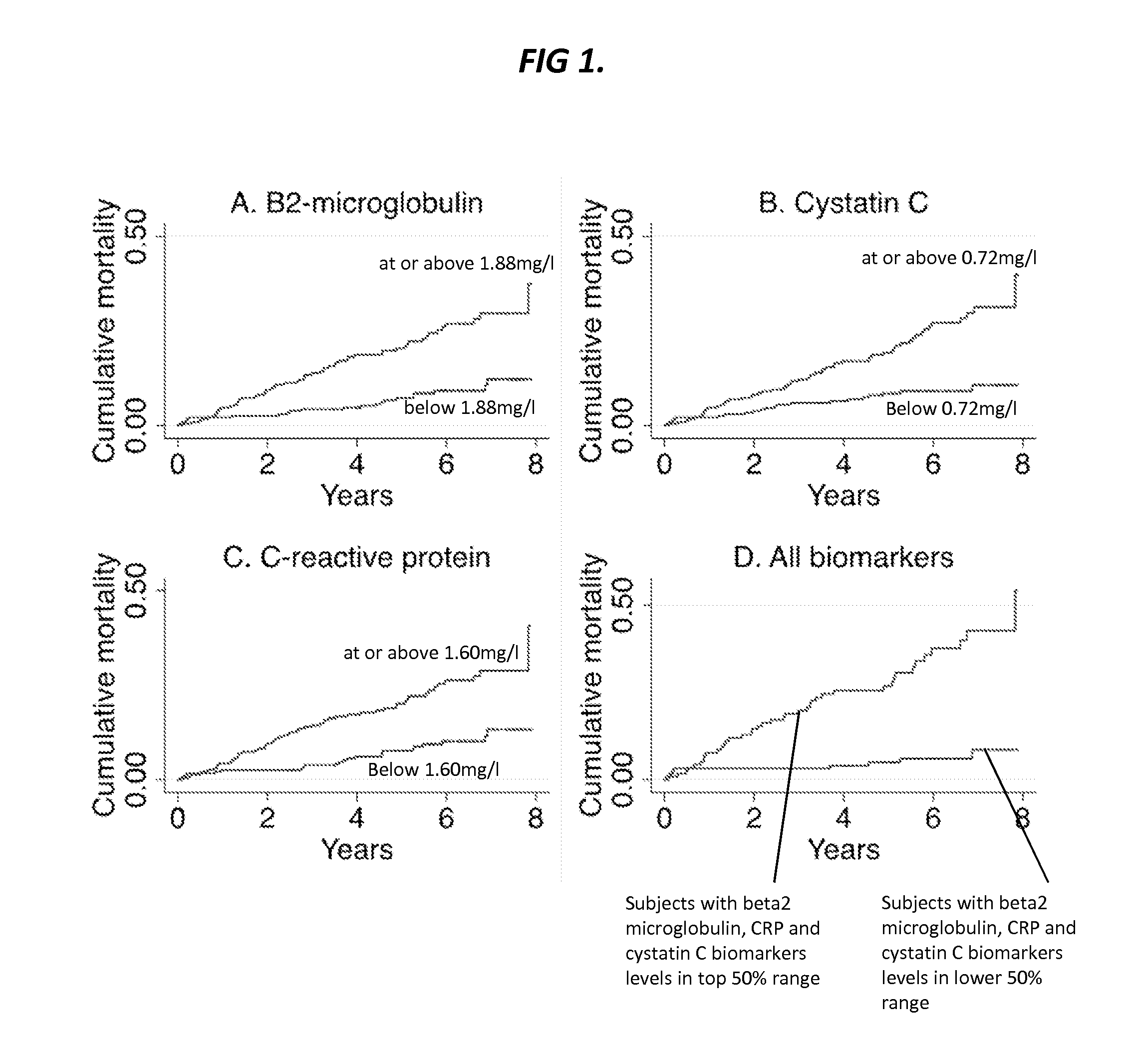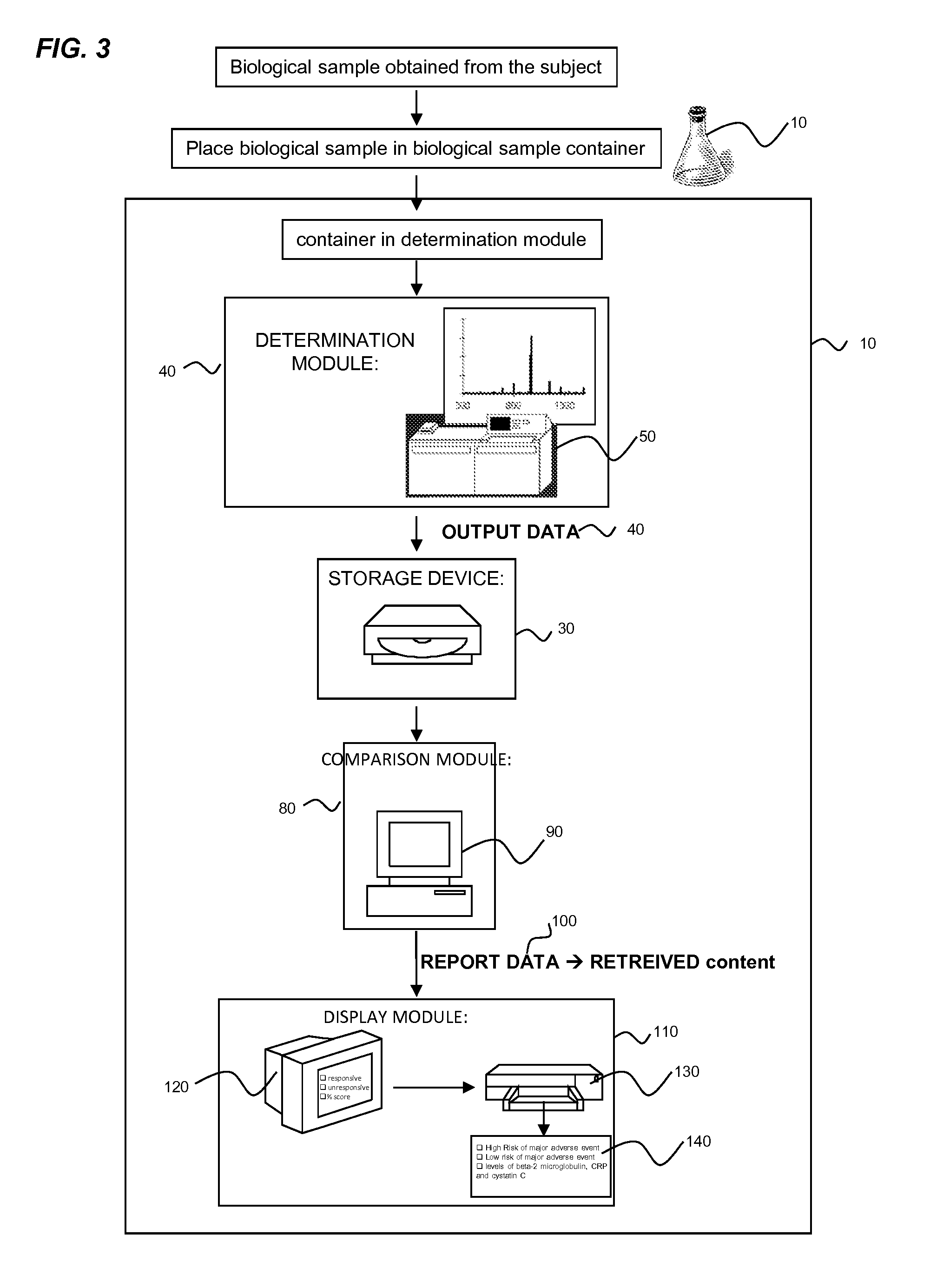Biomarkers for predicting major adverse events
a biomarker and major adverse event technology, applied in the field of diagnostics, can solve the problems of no better diagnosis rate for patients cared for by cardiologists, and increased risk of adverse outcomes
- Summary
- Abstract
- Description
- Claims
- Application Information
AI Technical Summary
Benefits of technology
Problems solved by technology
Method used
Image
Examples
example 1
[0510]The Genetic Determinants of Peripheral Arterial Disease (GenePAD) study consists of individuals who underwent an elective, non-emergent coronary angiogram for angina, shortness of breath or an abnormal stress test at Stanford University or Mount Sinai Medical Centers between Jan. 1, 2004 and Mar. 1, 20083,4. As previously detailed5, a sub-cohort of individuals was selected from the total cohort (n=1755) to characterize the role of biomarkers in cardiovascular disease. There were 470 patients with data on all biomarkers and relevant covariates included in this study. All individuals provided written informed consent. The GenePAD study was approved by the Stanford University and Mount Sinai School of Medicine Committees for the Protection of Human Subjects.
[0511]The biomarkers assessed were beta-2-microglobulin, cystatin C and C-reactive protein. Fasting blood samples were collected while the patient was being prepped for scheduled coronary angiography. The biomarkers were measu...
example 2
[0522]Enrollment characteristics of the 470 individuals constituting the study sample are presented in Table 1. During a median follow-up period of 5.6 years there were 78 mortalities (17%) of which 19 were known to be from cardiovascular causes.
TABLE 1Baseline study population characteristics (n = 470).CharacteristicValueAge, mean (years) 67 ± 10Female226(48%)Caucasian253(54%)Black77(16%)Hispanic58(12%)Asian33(7%)Other*49(10%)Systolic blood pressure, mean (mm Hg)141 ± 22Body mass index, mean (kg / m2)29 ± 6Lipids, mean (mg / dl)Total cholesterol145 ± 38High-density lipoprotein cholesterol 42 ± 13Ever smoker267(57%)Use of cholesterol lowering medication301(64%)Use of antihypertensive medication391(83%)Use of insulin or oral hypoglycemics146(31%)Glomerular filtration rate, mean (mL / min / 1.73 m2) 79 ± 37Biomarker levels, median (mg / L) (IQR)Beta-2-microglobulin1.88(1.50-2.57)Cystatin C0.72(0.61-0.93)C-reactive protein1.60(0.60-4.30)Coronary artery disease (CAD)†219(47%)*Includes Asian-India...
example 3
[0534]The key finding of this study is that the measurement and incorporation of beta-2-microglobulin, cystatin C and C-reactive protein (CRP) into baseline risk models of cardiovascular disease and death significantly improved risk reclassification and discrimination in a high-risk group of patients undergoing coronary angiography. The inventors have discovered that all three biomarkers predict all-cause and cardiovascular mortality risk even when adjusting for a wide range of potential confounding factors. Importantly, these biomarkers predicted risk in a multi-ethnic cohort of both genders among individuals both with and without angiographic evidence of coronary artery disease, suggesting broad applicability in patients being considered for catheterization.
[0535]Novel treatment approaches have had a dramatic impact on cardiovascular outcomes over the last 30 years, with an approximate 30% reduction in cardiovascular mortality today compared to one generation ago19. However, cardi...
PUM
| Property | Measurement | Unit |
|---|---|---|
| concentration | aaaaa | aaaaa |
| pH | aaaaa | aaaaa |
| pH | aaaaa | aaaaa |
Abstract
Description
Claims
Application Information
 Login to View More
Login to View More - R&D
- Intellectual Property
- Life Sciences
- Materials
- Tech Scout
- Unparalleled Data Quality
- Higher Quality Content
- 60% Fewer Hallucinations
Browse by: Latest US Patents, China's latest patents, Technical Efficacy Thesaurus, Application Domain, Technology Topic, Popular Technical Reports.
© 2025 PatSnap. All rights reserved.Legal|Privacy policy|Modern Slavery Act Transparency Statement|Sitemap|About US| Contact US: help@patsnap.com



